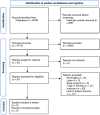The effect of fermented dairy intake and abdominal obesity in adults: a systematic review and dose-response meta-analysis of cohort studies
- PMID: 40055253
- PMCID: PMC11889060
- DOI: 10.1007/s40519-025-01733-4
The effect of fermented dairy intake and abdominal obesity in adults: a systematic review and dose-response meta-analysis of cohort studies
Abstract
Objectives: Diverse analysis has analyzed the potential efficacy of consuming foods created through the fermentation of dairy in mitigating abdominal obesity. The current meta-analysis aims to determine the impacts of consuming fermented dairy foods and the occurrence of abdominal obesity.
Methods: Web of Science, PubMed, and Scopus databases were queried for records published before January 13, 2023, to investigate proportionate cohort studies. We employed a random-effects model to appraise the relative risk (RR); effect size was assessed through the 95% confidence interval (CI). Additionally, a one-stage dose-response analysis was executed, quality assessment was conducted through the ROBINS-E tool.
Results: Consequently, five publications, comprising 41,430 cases, were included as selected studies. The pooled effect shows an effect on the abdominal obesity risk; however, the effect was not significant. Subgroup analyses revealed a potential risk reduction effect in high- and low-fat and fermented dairy productions, although the findings were not statistically significant. Furthermore, the dose-response analysis indicated a linear decrease in risk with increasing consumption of high-fat fermented yogurt, with an HR of 0.84 (95% CI 0.71, 0.99) by 8 servings/week and an HR of 0.37 (95% CI 0.19, 0.71) by 21 servings/week.
Conclusion: These findings imply the potential effectiveness of fermented dairy products, particularly high-fat yogurt, in diminishing the obesity risk. However, further research addressing the limitations of previous studies is essential to confirm these results. Evidence-based medicine level: No level of evidence: Level of evidence III. PROSPERO registration number: CRD42023387538 ( http://www.crd.york.ac.uk/PROSPERO ).
Keywords: Dose–response; Fermented dairy; Fermented foods; Meta-analysis; Obesity; Yogurt.
© 2025. The Author(s).
Conflict of interest statement
Declarations. Conflict of interest: The authors declare no competing interests.
Figures



References
-
- Chooi YC, Ding C, Magkos F (2019) The epidemiology of obesity. Metabolism 92:6–10 - PubMed
-
- Kelly T, Yang W, Chen CS, Reynolds K, He J (2008) Global burden of obesity in 2005 and projections to 2030. Int J Obes (Lond) 32(9):1431–1437 - PubMed
-
- Swinburn BA, Sacks G, Hall KD, McPherson K, Finegood DT, Moodie ML et al (2011) The global obesity pandemic: shaped by global drivers and local environments. Lancet 378(9793):804–814 - PubMed
-
- Finucane MM, Stevens GA, Cowan MJ, Danaei G, Lin JK, Paciorek CJ et al (2011) National, regional, and global trends in body-mass index since 1980: systematic analysis of health examination surveys and epidemiological studies with 960 country-years and 9·1 million participants. Lancet 377(9765):557–567 - PMC - PubMed
-
- Czernichow S, Kengne AP, Stamatakis E, Hamer M, Batty GD (2011) Body mass index, waist circumference and waist–hip ratio: which is the better discriminator of cardiovascular disease mortality risk?: evidence from an individual-participant meta-analysis of 82 864 participants from nine cohort studies. Obes Rev 12(9):680–687 - PMC - PubMed
Publication types
MeSH terms
LinkOut - more resources
Full Text Sources

